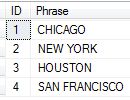Sort Letters in a Phrase using T-SQL
Problem definition
This article comes up from this creative question in MSDN forum. The problem is how can we sort the letters in a phrase just using T-SQL? To clarify the question, for instance the desired result for CHICAGO must be ACCGHIO.
Introduction
Because SQL is a Declarative Language in Relational System, it does not have arrays. Table is a relational variable that presents a relation, simply it is a Set that has no order. But if someone needs to do this sort in SQL Server, for example, because of a need to sort and compare in a huge table, how can we handle it?
Solution
By using T-SQL, because it has additional features even beyond relational; there is a solution to solve this problem. By the way, the first problem is how to assign array index to letters in a phrase?
One answer is to use spt_values helper table. Following sample code shows the functionality that will use later.
DECLARE @String VARCHAR(MAX)
SET @String = 'abc';
SELECT SUBSTRING(@String, 1 + Number, 1) [char] , number AS [Array Index]
FROM master..spt_values
WHERE Number < DATALENGTH(@String)
AND type = 'P';
The following figure shows the result of the code. It shows the array index assigned per letter.
Now it’s possible to solve the main problem. Next script produces the sample data.
/*Create sample table*/
IF OBJECT_ID('tempdb..#Text', 'U') IS NOT NULL
DROP TABLE #Test;
CREATE TABLE #Test
(
ID INT IDENTITY(1, 1) ,
Phrase VARCHAR(255)
);
/*Populate the table with sample data*/
INSERT #Test
( Phrase )
VALUES
( 'CHICAGO' ),
( 'NEW YORK' ),
( 'HOUSTON' ),
( 'SAN FRANCISCO' );
Following figure shows the sample data presentation.
Next code is the final solution.
/*This is the final solution*/
;
WITH base
AS ( SELECT L.[char] ,
T.ID ,
T.Phrase
FROM #Test T
CROSS APPLY ( SELECT SUBSTRING(T.Phrase, 1 + Number, 1) [char]
FROM master..spt_values
WHERE Number < DATALENGTH(T.Phrase)
AND type = 'P'
) L
)
SELECT DISTINCT
b1.Phrase ,
REPLACE(( SELECT '' + [char]
FROM base b2
WHERE b1.Phrase = b2.Phrase
ORDER BY [char]
FOR
XML PATH('')
), ' ', ' ') AS columns2
FROM base AS b1;
The final result shown in the following figure.
Limitations
Using this solution has two limitations that come from the spt_value helper table. These limits are:
1. Data Type
The spt_value return extra records for Unicode data types. So the data type cannot be Unicode such as NVARCHAR.
2. Data Length
The length of the data type could be up to 2048.
See Also
- T-SQL: Applying APPLY Operator
- SQL Server Query Language - Transact-SQL
- CSV formated output for any table using TSQL
- Query Master Data with Details as CSV


